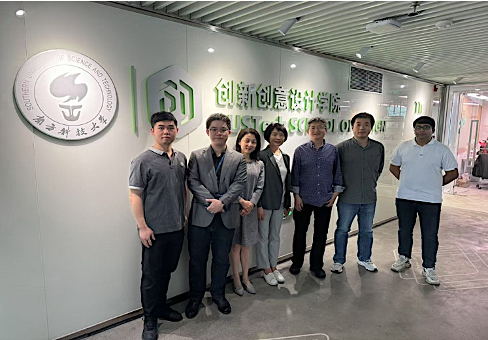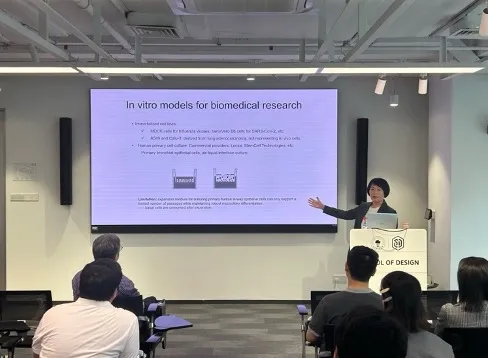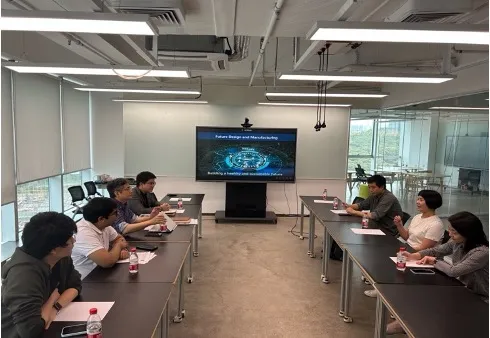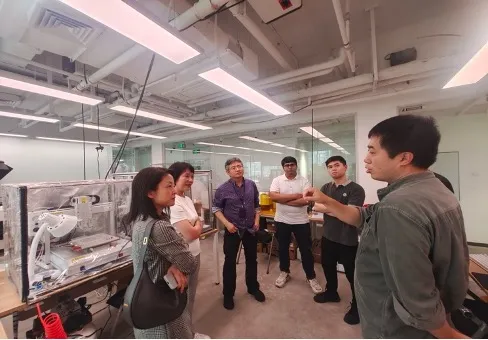Apr 8. 2025 - Latest News
As a cutting-edge model, organoid technology is opening new avenues for drug discovery and the exploration of disease mechanisms amid the rapid evolution of biomedical research. With the deepening integration of biomedicine and intelligent manufacturing, interdisciplinary collaboration is becoming a key driver of innovation. The University of Hong Kong (HKU), a global leader in medical research, has achieved numerous groundbreaking advancements in microbiology, organoid technology, and precision medicine. Meanwhile, the School of Design at Southern University of Science and Technology (SUSTech), led by Professor Hao Liang’s research group, is at the forefront of intelligent design, particularly in additive manufacturing and its applications in biomedical interfaces.
On March 12, SUSTech’s School of Design hosted Professor Zhou Jie from HKU, along with Dr. Zhang Yong, CEO of BiGan Bio, and Dr. Huang Lin, the company’s Chief Scientist, for an academic visit and research exchange. The discussions focused on the application of organoid technology in disease modeling, drug screening, and clinical translation. In addition, the visiting experts delivered a lecture titled “Disease Modeling in the Organoid Era,” which attracted a large audience of faculty, students, and professionals from academia, industry, and research sectors.

Figure 1. Group photo of guests and hosts
Organoids are three-dimensional microstructures cultured in vitro using stem cells or specific tissue cells that simulate the architecture and functionality of real organs. They are primarily used in disease modeling, drug testing, and regenerative medicine. Professor Zhou Jie’s team has made several pioneering contributions in this field, including the development of the world’s first human respiratory organoid culture system and the first bat intestinal organoid model. These physiologically relevant models provide a powerful platform for virology research, antiviral drug screening, and antibody efficacy testing. Notably, the team’s respiratory organoid technology was awarded a Gold Medal at the 48th International Exhibition of Inventions in Geneva. In her lecture, Professor Zhou highlighted the potential of organoids in simulating microbial infections, enabling personalized medicine, and advancing regenerative therapies, while also sharing her team’s latest achievements in organoid culture and application.

Figure 2. Prof. Zhou Jie gives a lecture on ‘Organoid’
During the exchange, Professor Hao Liang’s team showcased the synergistic potential of intelligent design and additive manufacturing in biomedical applications, highlighting their strengths in chip design and the development of precision instruments. Building on this foundation, the expert team shared insights into frontier medical research, particularly recent breakthroughs in organoid cultivation. The two sides engaged in an in-depth discussion on interdisciplinary collaboration across medicine, engineering, and design, exploring how SUSTech’s capabilities in intelligent design can complement HKU’s strengths in biomedical research to accelerate the clinical adoption of organoid technologies and personalized therapies. This exchange established new avenues for cooperation within the Guangdong–Hong Kong–Macao Greater Bay Area and laid the groundwork for future collaborative research in biomedical engineering.

Figure 3. Prof. Hao Liang's team communicating with the expert team
Professor Zhou emphasized that combining organoid technology with intelligent design and renewable materials will significantly advance precision medicine. Professor Hao Liang echoed this sentiment, stating: “The deep integration of academic research, clinical resources, and industrial investment is crucial to overcoming technological barriers. By fusing intelligent design with precision manufacturing, we aim to collaborate with global research teams to enhance organoid culture platforms, develop organoid chips, and facilitate their application in precision medicine, biomedical research, and drug discovery—ultimately delivering sustainable solutions for human health.”
This academic exchange has strengthened collaboration among research teams in the Greater Bay Area and provided a foundation for integrating organoid technology with intelligent manufacturing. Moving forward, both sides will focus on the critical nexus of organoid development, smart manufacturing, and clinical translation. By leveraging interdisciplinary synergies across medicine, engineering, and design, the collaboration aims to drive technological breakthroughs and application transformation. The teams will work together to standardize and industrialize organoid chip production and accelerate the integration of cutting-edge technologies into drug development and precision medicine, offering new momentum for global biomedical innovation.

Figure 4. Technical exchange in the laboratory
Contributor | Huang Ziqiang
Review | Li Xu, Hao Liang